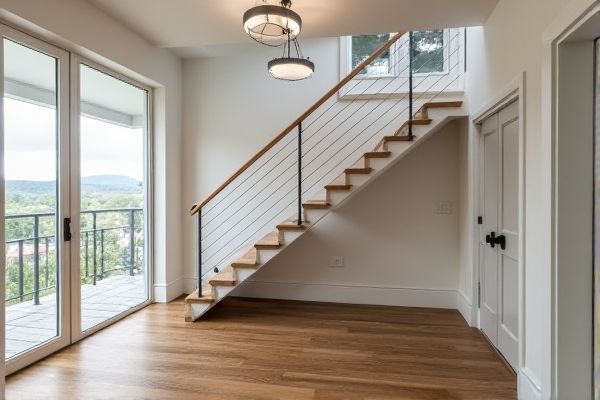
Cable railing offers a sleek, modern look with excellent durability and minimal maintenance, making it ideal for outdoor spaces requiring unobstructed views. Rod railing provides a more solid, traditional appearance with customizable spacing and stronger support; explore the rest of this article to determine which option best suits your design needs.
Table of Comparison
| Feature | Cable Railing | Rod Railing |
|---|---|---|
| Material | Stainless steel cables | Stainless steel or metal rods |
| Appearance | Sleek, modern, minimalistic | Sturdy, bold, industrial |
| Installation | Requires tensioning system, easier on straight runs | Rod fittings or welded, more labor-intensive |
| Durability | Corrosion-resistant, flexible | Highly durable, less flexible |
| Maintenance | Occasional tension adjustment and cleaning | Minimal, mostly cleaning |
| Cost | Moderate to high | High |
| Safety | Good visibility, minimal obstruction | Strong barrier, more obstruction |
| Common Use | Residential decks, stairs, balconies | Commercial spaces, modern interiors |
Introduction to Cable Railing and Rod Railing
Cable railing features stainless steel cables tensioned horizontally between posts, providing a sleek, modern look and unobstructed views ideal for decks and balconies. Rod railing uses solid metal rods, typically vertical or horizontal, offering a more rigid structure with a contemporary or industrial aesthetic. Both systems prioritize safety and durability, with cable railing emphasizing minimalistic transparency and rod railing focusing on structural strength and design versatility.
Design Differences: Cable vs Rod Railing
Cable railing features thin, horizontal stainless steel cables that create a sleek, minimalist look, ideal for modern and open designs, while rod railing uses vertical or horizontal metal rods that offer a more traditional or industrial aesthetic with varied spacing options. Cable railing systems provide greater transparency and unobstructed views, making them perfect for outdoor decks and balconies where visibility is key. Your choice between cable and rod railing impacts both the visual openness and structural rhythm of your railing design.
Material Options and Durability
Cable railing typically features stainless steel cables known for their high tensile strength and resistance to corrosion, making them ideal for outdoor use in various weather conditions. Rod railing systems utilize metal rods, often stainless steel or aluminum, which offer robust durability but may require more maintenance to prevent oxidation or wear over time. Your choice between these materials should consider the environmental exposure and long-term durability requirements of your railing installation.
Installation Process Comparison
Cable railing installation involves threading stainless steel cables through pre-drilled posts, requiring precise tensioning tools to ensure safety and durability. Rod railing systems use thicker metal rods that often require specialized fittings and welding or threaded fasteners, making the process more complex and labor-intensive. While cable railings offer quicker assembly with minimal tools, rod railings demand more expertise and time due to their rigid components and heavier hardware.
Aesthetic Appeal: Modern vs Traditional Styles
Cable railing offers a sleek, modern aesthetic with thin, horizontal stainless steel cables that create an open, minimalist look ideal for contemporary spaces. Rod railing typically features vertical or horizontal metal rods with a more traditional appearance, complementing classic or rustic architectural styles. Choosing between the two depends on whether your design preference leans toward a modern, unobstructed view or a traditional, structured feel.
Maintenance Requirements
Cable railing demands regular cleaning and tension adjustments to prevent corrosion and ensure safety, especially in outdoor environments. Rod railing typically requires less frequent maintenance but may need occasional tightening and rust protection depending on the material. Choosing between cable and rod railing depends on your preference for upkeep frequency and ease of maintenance.
Safety and Building Code Compliance
Cable railing systems offer superior safety due to their flexibility and tensioned wires that create a continuous barrier, reducing the risk of gaps that could cause falls. Rod railings must meet specific building code requirements, such as spacing to prevent child entrapment and adequate strength to withstand impact loads, but they may require more frequent maintenance to ensure compliance over time. Your choice should prioritize local building codes and the ongoing inspection needs to ensure the railing system maintains optimal safety standards.
Cost Analysis: Initial and Long-term Investment
Cable railing typically has a lower initial cost compared to rod railing due to simpler materials and installation processes, making it a budget-friendly option for many homeowners. Long-term investment favors cable railing as it requires less maintenance, with durable stainless steel cables resistant to corrosion and weathering, whereas rod railing may incur higher upkeep costs due to potential rust and tightening needs. Evaluating both options, cable railing offers a more cost-effective solution over time without compromising on durability or aesthetic appeal.
Ideal Applications for Each Railing Type
Cable railing is ideal for modern decks, balconies, and staircases that require unobstructed views and a sleek, minimalist aesthetic. Rod railing suits spaces needing stronger structural support and a more traditional or industrial design, often found in commercial buildings or rustic homes. Your choice depends on whether visual openness or robust durability best fits your specific architectural and safety needs.
Making the Right Choice: Which Railing is Best for You?
Cable railing offers a sleek, modern look with minimal obstruction for panoramic views and requires less maintenance due to its rust-resistant materials, making it ideal for outdoor spaces near water or in coastal areas. Rod railing provides a sturdier, more traditional aesthetic with versatile design options and stronger support, often preferred for interior staircases or areas needing enhanced safety. Your decision should consider factors like style preference, environmental exposure, maintenance effort, and safety requirements to ensure the railing complements your space and meets functional needs.
 homyna.com
homyna.com